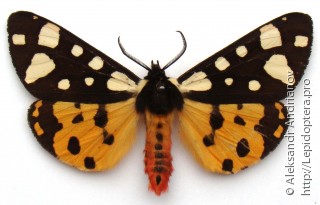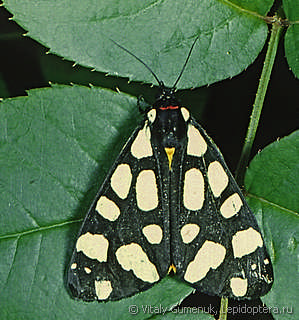Epicallia villica
Taxonomy
class Insecta
Species name(s)
Epicallia villica Linnaeus, 1758 = Arctia villica (Linnaeus, 1758) = Phalaena villica = floresi Agenjo, 1942. [3, 9, 10, 85]
Cream-spot Tiger.
urn:lsid:insecta.pro:taxonomy:15022
Expansion
This species marks on the maps: 4.
Zoogeographical regions
Palaearctic.
Russia regions
#1. Kaliningradsky; #4. Evropeisky Severo-Zapadny; #6. Evropeisky Severo-Vostochny; #7. Evropeisky yuzhno-tayozhny; #8. Evropeisky Tsentralny; #9. Evropeisky Tsentralno-Chernozyomny; #10. Sredne-Volzhsky; #11. Volgo-Donsky; #12. Nizhnevolzhsky; #13. Zapadno-Kavkazsky; #14. Vostochno-Kavkazsky; #17. Yuzhno-Uralsky; #20. Yuzhno-Zapadnosibirsky.
Wingspan
55—68 mm.
Primary colors
Red, Orange, Yellow, Brown/Gray/Black.
Flight time
| January | February | March | April | May | June | July | August | September | October | November | December |
Detailed information with references
Taxonomy, synonyms and combinations
Distribution
Imago Habitus and Differences from alike species
Imago lifespan
Larva food plants / other food objects
Subspecies of Epicallia villica
- Epicallia villica angelica (Boisduval, 1829). [9]
- E. v. confluens (Romanoff, 1884). [9]
- E. v. fulminans (Staudinger, 1871). [9]
- E. v. marchandi (de Freina, 1983). [9]
- E. v. villica. [9]
Authors
Initial species uploading to the site: Peter Khramov.
Text data: Peter Khramov, Vasiliy Feoktistov.
The species characteristics formalization: Peter Khramov, Vasiliy Feoktistov.
References
- [1] O. Karsholt, J. Razowski (eds.), 1996. The Lepidoptera of Europe: a distributional checklist
- [3] Каталог чешуекрылых (Lepidoptera) России. Под ред. С. Ю. Синёва. СПб.; М.: Товарищество научных изданий КМК, 2008
- [5] Райххолф-Рим Х. Бабочки. М.: Астрель, 2002
- [9] Tree of Life (funet.fi), 2012
- [10] de Jong, Y.S.D.M. (ed.) (2011) Fauna Europaea version 2.4 (faunaeur.org)
- [85] Lepidoptera species catalogue, Lepidoptera.ru, 2015
- [PC93] Vasiliy Feoktistov
Comments
Note: you should have a Insecta.pro account to upload new topics and comments. Please, create an account or log in to add comments
Epicallia villica photos










































All the photos of the species in large size
Please, create an account or log in to upload your photo

